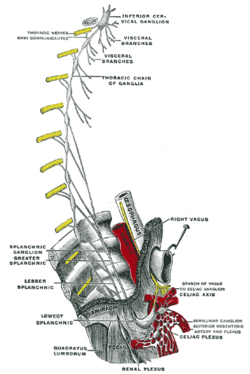Stellate ganglion
| Stellate ganglion | |
|---|---|
 Plan of right sympathetic cord and splanchnic nerves. (Stellate ganglion not visible, but region is shown.) | |
| Details | |
| From | inferior cervical ganglion, first thoracic ganglia |
| Identifiers | |
| Latin | ganglion cervicothoracicum, ganglion stellatum |
| MeSH | A08.340.315.350.800 |
| TA | A14.3.01.020 |
| FMA | 6469 |
The stellate ganglion (or cervicothoracic ganglion) is a sympathetic ganglion formed by the fusion of the inferior cervical ganglion and the first thoracic ganglion, which exists in 80% of cases. Stellate ganglion is located at the level of C7 (7th cervical vertebrae), anterior to the transverse process of C7, superior to the neck of the first rib, and just below the subclavian artery.
Clinical significance
The clinical significance of these ganglia is that they may be cut in order to decrease the symptoms exhibited by Raynaud's phenomenon and hyperhydrosis (extreme sweating) of the hands. Injection of local anesthetics near the stellate ganglion can sometimes mitigate the symptoms of sympathetically mediated pain such as complex regional pain syndrome type I (reflex sympathetic dystrophy). Injection is often given near the Chassaignac's Tubercle (anterior tubercle of transverse process of C6) due to this being an important landmark lateral to the cricoid cartilage. It is thought that anesthetic is spread along the paravertebral muscles to the stellate ganglion.
Stellate-ganglion block also shows great potential as a means of reducing the number of hot flushes and night awakenings suffered by breast cancer survivors and women experiencing extreme menopause.[1]
Complications associated with a stellate ganglion block include Horner's syndrome, intra-arterial or intravenous injection, difficulty swallowing, vocal cord paralysis, epidural spread of local anaesthetic and pneumothorax.
Blunt needling of the stellate ganglion with an acupuncture needle is used in Traditional Chinese Medicine to decrease sympathetically mediated symptoms as well.
Block of the stellate ganglion has also been explored in coronary artery bypass surgery.[2]
Anatomy
The stellate ganglion lies in front of the neck of the first rib. The vertebral artery lies anterior to the ganglion as it has just originated from the subclavian artery. After passing over the ganglion, the artery enters the vertebral foramen and lies posterior to the anterior tubercle of C6 (Chassaignac's Tubercle).[3]
References
- ↑ Lancet, 2008
- ↑ Yildirim V, Akay HT, Bingol H, et al. (2007). "Pre-emptive stellate ganglion block increases the patency of radial artery grafts in coronary artery bypass surgery". Acta anaesthesiologica Scandinavica. 51 (4): 434–40. doi:10.1111/j.1399-6576.2006.01260.x. PMID 17378781.
- ↑ Raj, Practical Management of Pain, 3rd ed, pp656-657